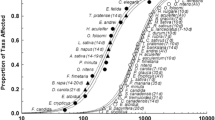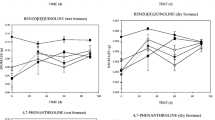Abstract
This article summarizes historical and recent research on the terrestrial toxicology of tetrabromobisphenol A (TBBPA). Despite its ubiquitous use and presence in the environment, little published data is available to evaluate the terrestrial ecotoxicity of TBBPA. The purposes of this paper are to enable broad access to a series of TBBPA ecotoxicity tests (nitrogen transformation, earthworm survival/reproduction, and seedling emergence/growth) that were conducted in support of regulatory risk assessments, and to summarize available research in the terrestrial toxicity of TBBPA. In these studies, no significant effect of TBBPA on nitrogen transformation was observed up to the highest concentration [1000 mg/kg dry weight (d.w.) soil]. The no-observed-effect concentrations (NOECs) for seedling emergence ranged from 20 to 5000 mg/kg d.w. Sensitivities were soybeans < corn ≈ onion ≈ tomato < ryegrass < cucumber; the most sensitive endpoints being seedling dry weight and height. The 28-day earthworm mortality NOEC was > 4840 mg/kg d.w. The most sensitive terrestrial endpoint was earthworm reproduction with a half maximal effective concentration (EC50) of 0.12 mg/kg d.w. soil. Based on this sensitive terrestrial endpoint, the EU derived a predicted no-effect concentration (PNEC) for soil of 0.012 mg/kg wet weight soil (EU 2008). We did not identify a more sensitive/lower point of departure for terrestrial toxicity endpoints in the published literature. On the basis of this PNEC, the EU concluded there was potential risk for environmental effects near TBBPA manufacturing sites, but no additional risk provided that no sewage sludge was applied to agricultural land (EU 2008).
Similar content being viewed by others
References
Chen X, Gu J, Wang Y, Gu X, Zhao X, Wang X, Ji R (2017) Fate and O-methylating detoxification of tetrabromobisphenol A (TBBPA) in two earthworms (Metaphire guillelmi and Eisenia fetida). Environ Pollut 227:526–533
Environment Canada (EC) (2013) Screening assessment report: phenol, 4,4′-(1- methylethylidene) bis[2,6-dibromo-; ethanol, 2,2′-[(1-methylethylidene)bis[(2,6-dibromo-4,1-phenylene)oxy]]bis; benzene, 1,1′-(1-methylethylidene)bis[3,5- dibromo-4-(2-propenyloxy). Environment Canada, Health Canada: Canada
EU (European Union) (1993) Council Regulation (EEC) No 793/93 of 23 March 1993 on the evaluation and control of the risks of existing substances 1993
EU (European Union) (2006) Regulation (EC) No 1907/2006 of the European Parliament and of the Council of 18 December 2006 concerning the Registration, Evaluation, Authorisation and Restriction of Chemicals (REACH), establishing a European Chemicals Agency, E.P.a. Council, Editor
European Chemicals Agency (ECHA) (2018) Brief profile: 2,2′,6,6′-tetrabromo-4,4′-isopropylidenediphenol. Available online at: https://www.echa.europa.eu/web/guest/brief-profile/-/briefprofile/100.001.125 [accessed 30 April 2018]
European Union (EU) (2008) Risk assessment of 2,2′,6,6’Tetrabromo-isopropylidene diphenol (Tetrabromobisphenol-A). CAS Number: 79-94-7 EINECS Number: 201-236-9. Final environmental draft. United Kingdom Environment Agency, Wallingford
Fraunhofer IME (Institute for Molecular Biology and Applied Ecology) (2011) Literature review on monitoring studies covering TBBPA and its potential transformation products (monomethyl / dimethyl ether derivatives of TBBPA). Report. Literature review for the Bromine Science and Environmental Forum, Brussels
Ge H, Zhang F (2017) Effects of tetrabromobisphenol A stress on growth and physiological characteristics of soybean seedling. Bull Environ Contam Toxicol 98(1):141–146
Gu J, Jing Y, Ma Y, Sun F, Wang L, Chen J, Guo H, Ji R (2017) Effects of the earthworm Metaphire guillelmi on the mineralization, metabolism, and bound-residue formation of tetrabromobisphenol A (TBBPA) in soil. Sci Total Environ 595:528–536
He M-J, Luo X-J, Yu L-H, Liu J, Zhang X-L, Chen S-J, Chen D, Mai B-X (2010) Tetrabromobisphenol-A and hexabromocyclododecane in birds from an e-waste region in South China: influence of diet on diastereoisomer- and enantiomer-specific distribution and trophodynamics. Environ Sci Technol 44:5748–5754
Jin J, Peng H, Wang Y, Liu W, Yang R (2007) Determination of tetrabromobisphenol-A (TBBP-A) in soil and sediment samples by ultra-performance liquid chromatography with quattro premier mass spectrometer. Abstract from the Fourth International Workshop on Brominated Flame Retardants BFR2007
Li Y, Zhou Q, Li F, Liu X, Luo Y (2008) Effects of tetrabromobisphenol A as an emerging pollutant on wheat (Triticum aestivum) at biochemical levels. Chemosphere 74:119–124
Li Y, Zhou Q, Wang Y, Xie X (2011) Fate of tetrabromobisphenol A and hexabromocyclododecane brominated flame retardants in soil and uptake by plants. Chemosphere 82:204–209
Lieke T, Steinberg CE, Ju J, Saul N (2015) Natural marine and synthetic xenobiotics get on nematode’s nerves: neuro-stimulating and neurotoxic findings in Caenorhabditis elegans. Mar Drugs 13(5):2785–2812
Liu K, Li J, Yan S, Zhang W, Li Y, Han D (2016) A review of status of tetrabromobisphenol A (TBBPA) in China. Chemosphere 148:8e20
Lu L, Yang Y, Zhang J, Shao B (2014) Determination of seven bisphenol analogues in reed and Callitrichaceae by ultra performance liquid chromatography-tandem mass spectrometry. J Chromatogr B Anal Technol Biomed Life Sci 953-954:80–85
Matsukami H, Tue NM, Suzuki G, Someya M, Tuyen LH, Viet PH, Takahashi S, Tanabe S, Takigami H (2015) Flame retardant emission from e-waste recycling operation in northern Vietnam: environmental occurrence of emerging organophosphorus esters used as alternatives for PBDEs. Sci Total Environ 514:492–499
McAvoy DC, Pittinger CA, Willis AM (2016) Biotransformation of tetrabromobisphenol A (TBBPA) in freshwater sediments, agricultural soils, and anaerobic digester sludge. Ecotoxicol Environ Saf 131:143–150
OECD (Organization for Economic Cooperation and Development) (1984) OECD guidelines 207—earthworm, acute toxicity tests
OECD (Organization for Economic Cooperation and Development) (1998) OECD guideline no. 208—terrestrial plant test: seedling emergence and seedling growth test
OECD (Organization for Economic Cooperation and Development) (2000a) OECD Guideline 216 – Soil Microorganisms: Nitrogen Transformation Test
OECD (Organization for Economic Cooperation and Development) (2000b) OECD guidelines additional OECD guidance included proposed guideline – earthworm reproduction test (Eisenia fetida/andrei)
OECD (Organization for Economic Cooperation and Development) (2004) OECD guidelines 222 – earthworm reproduction test (Eisenia fetida/Eisenia andrei)
Pittinger C, Pecquet AM (2018) Review of historical aquatic toxicity and bioconcentration data for the brominated flame retardant tetrabromobisphenol A (TBBPA): effects to fish, invertebrates, algae, and microbial communities. Environ Sci and Pollut Res. https://doi.org/10.1007/s11356-018-1998-y
Qu G, Liu A, Wang T, Zhang C, Fu J, Yu M, Sun J, Zhu N, Li Z, Wei G, Du Y, Shi J, Liu S, Jiang G (2013) Identification of tetrabromobisphenol A allyl ether and tetrabromobisphenol A 2,3-dibromopropyl ether in the ambient environment near a manufacturing site and in mollusks at a coastal region. Environ Sci Technol 47:4760–4767
Sánchez-Brunete C, Miguel E, Tadeo JL (2009) Determination of tetrabromobisphenol-a, tetrachlorobisphenol-A and bisphenol-A in soil by ultrasonic assisted extraction and gas chromatography–mass spectrometry. J Chromatog A 1216:5497–5503
Saul N, Baberschke N, Chakrabarti S, Stürzenbaum SR, Lieke T, Menzel R, Jonas A, Steinberg CEW (2014) Two organobromines trigger lifespan, growth, reproductive and transcriptional changes in Caenorhabditis elegans. Environ Sci Pollut Res 21:10419–10431
Shi YJ, Xu XB, Zheng XQ, Lu YL (2015) Responses of growth inhibition and antioxidant gene expression in earthworms (Eisenia fetida) exposed to tetrabromobisphenol A, hexabromocyclododecane and decabromodiphenyl ether. Comp Biochem Physiol C Toxicol Pharmacol 174-175:32–38
Sun Y, Guo H, Yu H, Wang X, Wu J, Xue Y (2008) Bioaccumulation and physiological effects of tetrabromobisphenol A in coontail Ceratophyllum demersum L. Chemosphere 70:1787–1795
Sun F, Kolvenbach BA, Nastold P, Jiang B, Ji R, Corvini PF (2014) Degradation and metabolism of tetrabromobisphenol A (TBBPA) in submerged soil and soil-plant systems. Environ Sci Technol 48:14291–14299
Sverdrup LE, Hartnik T, Mariussen E, Jensen J (2006) Toxicity of three halogenated flame retardants to nitrifying bacteria, red clover (Trifolium pratense), and a soil invertebrate (Enchytraeus crypticus). Chemosphere 64:96–103
U.S. EPA (United States Environmental Protection Agency) (1996) OPPTS guideline 850.6200 – earthworm subchronic toxicity test
Wang J, Liu L, Wang J, Pan B, Fu X, Zhang G, Zhang L, Lin K (2015) Distribution of metals and brominated flame retardants (BFRs) in sediments, soils and plants from an informal e-waste dismantling site, South China. Environ Sci Pollut Res 22:1020–1033
Wildlife International (2002) Tetrabromobisphenol A: a toxicity test to determine the effects of the test substance on seedling emergence of six species of plants. Wildlife International Project No 439–102
Wildlife International (2003) Effect of tetrabromobisphenol A on the survival and reproduction of the earthworm, Eisenia fetida. ABC study no. 47014; Wildlife International Project No 439C-131
Wildlife International (2005a) Tetrabromobisphenol-A (TBBPA): soil microorganisms: nitrogen transformation test. Wildlife International Ltd., Project Number: 439E-109
Wildlife International (2005b) Effect of tetrabromobisphenol A on the reproduction of the Earthworm, Eisenia fetida. ABC Study No. 49264; Wildlife International Project No. 439C- l 45
Xu T, Wang J, Liu S-z LC, Shelver WL, Li QX, Li J (2012) A highly sensitive and selective immunoassay for the detection of tetrabromobisphenol A in soil and sediment. Anal Chim Acta 751:119–127
Xue Y, Gu X, Wang X, Sun C, Xu X, Sun J, Zhang B (2009) The hydroxyl radical generation and oxidative stress for the earthworm Eisenia fetida exposed to tetrabromobisphenol A. Ecotoxicology 18:693–699
Zhu Z-C, Chen S-J, Zheng J, Tian M, Feng A-H, Luo X-J, Mai B-X (2014) Occurrence of brominated flame retardants (BFRs), organochlorine pesticides (OCPs), and polychlorinated biphenyls (PCBs) in agricultural soils in a BFR-manufacturing region of North China. Sci Total Environ 481:47–54
Acknowledgements
The authors thank the members of the American Chemistry Council’s North American Flame Retardant Alliance, Albemarle Corporation, Chemtura, and ICL-IP, for the financial support in preparing this manuscript and for making the laboratory study reports available for review by the authors. We thank Agvise Laboratories (Northwood, ND) for providing soils, Wildlife International and ABC Labs for conducting the studies. We also acknowledge the study directors who conducted these studies, including E.C. Schaefer, J.R. Porch, T.Z. Kendall, R. Warbritton, and J. Aufderheide.
Author information
Authors and Affiliations
Corresponding author
Additional information
Responsible editor: Philippe Garrigues
Electronic supplementary material
ESM 1
(DOCX 90 kb)
Rights and permissions
About this article
Cite this article
Rothenbacher, K.P., Pecquet, A.M. Summary of historical terrestrial toxicity data for the brominated flame retardant tetrabromobisphenol A (TBBPA): effects on soil microorganisms, earthworms, and seedling emergence. Environ Sci Pollut Res 25, 17268–17277 (2018). https://doi.org/10.1007/s11356-018-2255-0
Received:
Accepted:
Published:
Issue Date:
DOI: https://doi.org/10.1007/s11356-018-2255-0




